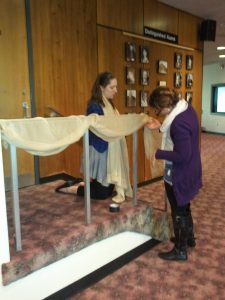
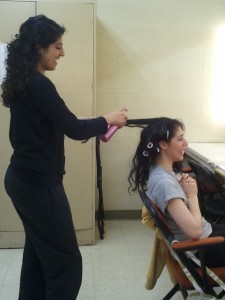


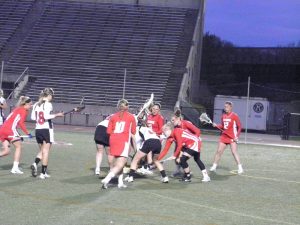
After a quick and early seven-goal run by Wittenberg, the Bishops were not able to push back with a scoring run of their own in a game dictated by scoring streaks on Wednesday, April 11 at Selby Stadium.
The Wittenberg Tigers won the game by a score of 17-10.
In just the first half of the first period, Wittenberg unleashed their seven-goal streak.
Junior Annie Swanson, who was the leading Bishop scorer with three goals, said Wittenberg scored mainly because the Ohio Wesleyan team was shocked.
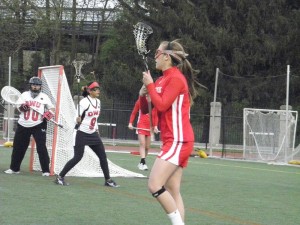
“We got a little frazzled at times, and I think that that was mental,” Swanson said.
Wittenberg’s scoring run did not go unanswered, however.
The Bishops, from the middle of the first half to the top of the second, scored six straight goals, which brought them only a point from the Tiger’s lead.
The Bishop’s run was broken by an unassisted Wittenberg goal by junior midfielder Erin Guiliano, who eventually helped propel another five-goal scoring run by Wittenberg.
Meg Grossman, head coach of the women’s Bishop lacrosse team, said Guiliano’s score was when things started to fall for OWU.
“Our (team’s) momentum got halted by Wittenberg’s goal,” she said.
Junior Molly Curry, like Swanson, said the game was definitely mental.
“You know we had the ability. You could tell by the way we scored,” Curry said.
The game was a “Red Alert” game, meaning it was highly publicized by the Spirit and Homecoming Organization (SHO).
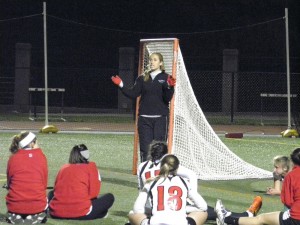
Junior Clare Whitaker, president of SHO, said the game was a success.
“It raised awareness and school spirit at sporting events. I think it worked,” Whitaker said.
“There were more fans here this time then the rest of the season.”
Grossman said the game was nothing for the Bishops to hang their heads about.
“It showed us aspects of the team: team cohesion, being constructive, and keeping level heads,” Grossman said.
“It’s going to be a hard-fought rest of the season,” she said.
It was the Bishop’s second conference match.
The women’s lacrosse team has lost the first two of their conference matches as of April 16 against Wittenberg and Allegheny College.
The record stands at 6-4 overall. On Sunday, April 22, the Bishops are playing another conference game against Oberlin at 1 p.m. in Oberlin, Ohio.
Many of the students in hooded sweatshirts on April 11 were not wearing them because of the cold. Instead, they wore them as a memorial to the life of Florida teen Trayvon Martin.
While the facts of his death are highly disputed, what is certain is that Martin, 17, was shot and killed by George Zimmerman, a neighborhood watch member. Zimmerman claimed self-defense. However, there are some people who say they believe that it was an act of racial profiling.
Wednesday marked the 44th day since the shooting and members of the Student Union on Black Awareness held a presentation to raise awareness of racial profiling.
Freshman SUBA member, Ty Manning, began the presentation.
“We stand here today for Trayvon Martin,” she said. “That night, apparently, that hoodie was his death sentence…We are here to let you know that while our voices are alive, Trayvon is not. Rest in peace, Trayvon Martin.”
Members of SUBA stood in two groups, with a projector screen showing images of protesters in between them. They all wore hoodies with cardboard signs draped over their chests.
“We do not stand for racial profiling,” read one of the signs. “I am Trayvon Martin,” proclaimed another.
Jon Powers, the University Chaplain, also stood in solidarity with the SUBA members. Powers said he was very aware of the Martin case and the possibility of racial profiling. He said he was very disturbed by it, calling racial profiling “a cultural crisis.”
After Manning’s speech, the SUBA members and others knelt in silent remembrance.
Freshman Garrison Davis, SUBA’s parliamentarian, said he wanted to see Zimmerman prosecuted.
“Let people know it’s a new day,” Davis said. “You can’t do whatever you want based off suspicion (and) off racism.”
Manning said that, while the presentation was not limited to the Martin case, it was a main focus.
Both Manning and Davis said they had been victims of racial profiling at a young age. Davis said police accused him of throwing a bottle at a football game when he was six.
“(A white friend of mine) was actually closer to where the bottle was thrown (from) but the cop still pulled me aside,” Davis said.
Manning described a field trip when she was eight. White parents of one of her classmates tried to keep their children away from her.
“I think that’s when I started learning the difference between being white and black,” Manning said.
Powers said racial profiling happens every day in America, even in Delaware.
“(When) Black students from Ohio Wesleyan go downtown to stores, they’re more likely to be followed by clerks than a white student would be,” Powers said.
“It’s in our culture, it’s just everywhere.”
Still, he hoped shedding light on the issue would be helpful and would instruct students on the realities of racial profiling.
Former Senior Marketing Executive for Kellog Company,Tom Fink, told students on March 9 that the world of marketing is rapidly changing due to advances in technology, during his visit to OWU.
While on campus, he met with students one-on-one, at dinner and lunch lectures, and in the classroom.
Fink said he was part of the “Leggo My Eggo” campaign at Kellogg Company before retiring.
He cites this as one of his major accomplishments.
He said his goal in the field of marketing was to work with consumer-packaged goods, among other areas.
Fink told students that developments in technology are forcing companies to change their marketing techniques by using social media and other modern tactics.
He said his goal was to teach students how to prepare for a career in marketing and how to develop a knowledge base that is transferable to working in the real world.
Fink said he thinks these events are important for students to attend because they can have access to the practical application of the theories they learn in the classroom. He also said it is a way to validate what they learn.
“I am a firm believer that any student can’t network enough,” Fink said.
John Boos, co-director of the Woltemade Center, said Fink is candidate for the position.
“An executive in residence essentially agrees to volunteer their expertise and services to the Center by making themselves available to guest lecture in various econ-management classes, present one or more Center lectures to the OWU community, and meet with students outside of class in an advisory capacity,” Boos said.
“After talking with Tom [Fink] and learning more about his education and corporate background, I think he could be a great Executive in Residence – if he was interested in periodically returning to OWU and working with the Center.”
Sophomore Cody Reinsel helped set up the dinner with Fink Monday at the Bigelow-Reed House where he said Fink talked about trends in consumer packaged goods marketing.
“I believe having programs like this available to students helps them out tremendously.” Reinsel said.
Reinsel said he believes every student, whether or not they are interested in business, should attend events like these.
Sophomore Jay Certo attended the dinner April 9 and the lunch the next day.
Certo said he would highly recommend other students to attend these types of events in order to meet people from a variety of fields with varying experiences.
Sophomore Sarah Jilbert also attended the dinner.
“This type of programming is extremely important to students because it gives us a way to connect and network with a variety of people who, otherwise, we would never meet,” she said.
“These are once in a lifetime opportunities, so it’s important for students to take advantage of speakers and events. The talks not only benefit economics majors, but all majors.”
Jilbert said she learned about the rapid changes occurring in the field of marketing from listening to Fink’s presentation.
“I will definitely attend more of these events because they’re a great chance to learn outside the classroom, and network,” Jilbert said.
“I would recommend other students attend these events. They will be surprised how much they learn and how much they will get out of the experience.”
Fink stayed in the Bigelow-Reed House apartment during the week of April 9 while visiting campus.
Fink is considering the position of Woltemade Center Executive in Residence as he looks into part-time teaching positions to fill his time now that he is offically retired.
His son, Chris Fink, is a professor in the physical education department and helped him pursue the job.
‘[
From April 1 to April 6, senior Misa Farslow’s SLU house project “Champions for Change” raised $215.78 for women’s shelters in Afghanistan.
Farslow is a member of the Women’s House (WoHo), a small living unit that works to raise awareness about women’s issues. She said that she, in collaboration with members of Delta Tau Delta fraternity, collected change for the organization Calling All Crows. She said 100 percent of the money made was going directly to the women in need in Afghanistan.
“These shelters provide a safe place for women to learn how to support themselves and their families after they have left their husbands or if their husbands have died,” Farslow said. “It gives them an opportunity they would not have had otherwise.”
Sophomore and Delt fraternity member Ryan Klein said the planning of the project started back in February.
Members of Delt who were especially involved in the project were Klein and sophomore Matt Wasserman. Both had different reasons for wanting to get involved personally, and wanted to get their whole fraternity involved, as well.
“The band State Radio, who I have been listening to for years, works with the Calling All Crows organization,” Wasserman said. “So I’ve known about what they do for years. Back home in Connecticut, my friend Oliver and I tried collecting change, but it never really amounted to anything significant. I thought that the Ohio Wesleyan campus would be a much better place to make a real impact.”
“I wanted to get Delt involved tabling with WoHo during the week, help make the poster to advertise the event, and most importantly, get other fraternities involved by giving them milk jugs to collect change within their house throughout the week,” Klein said. “This project means a lot to myself and to Delt because it betters the lives of impoverished women in Afghanistan, and in doing so, those in Greek life are working with those in SLUs, which does not happen enough.”
Farslow was glad the fraternity men wanted to be involved with her project.
“Ryan Klein and Matt Wasserman have been amazing,” Farslow said. “They contacted me about doing this project with Delt. It is nice to see the fraternities and SLUs working together.”
Though it does not happen often, this collaboration between Greek life and SLUs was incredibly successful in this project, according to those who helped.
“I enjoyed working with WoHo,” Klein said. Wasserman added, “When it comes to philanthropic endeavors, the people who need our help don’t ask ‘who is giving this money?’ so we shouldn’t discriminate either. Working together also pulls from different groups on campus, which will make charitable efforts more successful.”
Klein said he has talked to WoHo, and they want to do the project again next year. Wasserman said he hopes future members of Greek life and SLUs will want to work together more often.
“For the first time doing this project, I think this went well, and we will continue to improve and expand next year,” he said.
Elise Pitcairn
Delta Delta Delta
Elise is a freshman from Jupiter, Florida. Her favorite candy is dark chocolate, her favorite color is purple and breakfast is her favorite meal of the day.
She is planning on double majoring in Politics and Government and French. She is also excited to get involved in more campus activities as a sophomore.
“(I) took it easy freshman year, but I’m hoping to join WCSA and Big Brothers Big Sisters next year.”
A fun fact about Elise is that she loves snow. “I’m from Florida so everyone thinks it’s bizarre that I came to Ohio for college and even more so that I’m obsessed with the snow. I could play in the snow all day,” she says.
Her favorite Tri-Delt memory is from Delta Gamma’s Anchor Splash.
“All the pledges came together to create our dance/synchronized swimming routine for Anchor Splash. The first time we practiced in the deep end everyone nearly drowned from laughing so hard, but when we finished the dance I was so proud to be sisters with such fun and fabulous girls!”
April 9-15, 2012
4/9/12 4:40 p.m. – Public Safety dispatched to 9 Williams Drive on a fire alarm. The alarm was caused by smoke in the kitchen area.
4/11/12 4:01 p.m. – Public Safety dispatched to Stuyvesant Hall on a report of a fire in the bell tower. The fire had been extinguished by construction personnel prior to PS arriving on scene. Delaware City Fire inspectors were dispatched to the scene for further investigation.
4/11/12 5:13 p.m. – Public Safety responded to a welfare concern in Smith Hall. Delaware EMS transported an ill student to Grady ER for further evaluation and treatment.
4/12/12 2:53 p.m. – Public Safety dispatched to Hayes Hall on a welfare concern.
4/14/12 4:15 p.m. – A broken window was discovered in Merrick Hall during a routine Public Safety patrol. There was no sign of entry into the building.
They’re easy to recognize. Some touring students are wearing letter jackets, most have brought their parents, and each is carrying a red folder, the folder designating them as prospectives.
Some are from Ohio, having heard about OWU from older siblings or family friends. But how do the students hailing from Florida or California or Washington hear about OWU?
Their school may have been visited by an Admissions counselor, or they, too, may have heard about the school from someone they know. But many of them—or, more likely, their parents—spotted OWU on a national ranking list like that of U.S. News & World Report and decided to give the Battling Bishops a shot.
But are these national ranking lists accurate? How are the statistics in such national rankings decided? Does what a university is ranked even matter?
What’s the U.S. News & World Report ranking, and how is it determined?
In U.S. News & World Report’s 2011 Edition of America’s Best Colleges, Ohio Wesleyan University was ranked as one of the top liberal arts colleges. OWU, listed at number 102, was among 178 ranked liberal arts colleges.
But how are these rankings determined, and how does Ohio Wesleyan measure up to the other members of the Five Colleges of Ohio, colleges with which OWU competes for prospective students?
According to the U.S. News & World Report website, the 2011 Edition of America’s Best Colleges list is determined using quantitative data that higher-education experts have agreed reliably gauge a university’s quality. Colleges are classified by the type of institution; national universities or liberal arts colleges are two such classifications. U.S. News & World Report then collects data from the university which rates sixteen factors. These factors include the undergraduate academic reputation, student retention, amount of financial aid awarded, faculty resources, number of alumni who donate funds and more.
This is the complex process that places Ohio Wesleyan at 102, an impressive statistic when considering hundreds of liberal arts institutions operate in the U.S.
But it’s also the process that places the other members of the Five Colleges of Ohio—Denison University, the College of Wooster, Oberlin College, and Kenyon College—ahead of Ohio Wesleyan. Within the liberal arts classification, America’s Best Colleges puts Oberlin at 24; Kenyon at 33; Denison at 49; and Wooster at 71.
In terms of student population, the Five Colleges are comparable. As of 2010, Ohio Wesleyan was the second-smallest, boasting a student body of 1,919. Gambier, OH hosts Kenyon’s 1,632—the smallest student body—while Oberlin represents the largest of the Five with 2,974.
Despite Oberlin’s size, though, it also has a 31 percent acceptance rate—the lowest of the Five. This low score means it’s harder to get in, ostensibly upping the ante in terms of academics and student performance. Ohio Wesleyan, on the other hand, has the highest acceptance rate, at 69 percent.
Ohio Wesleyan German professor Thomas Wolber has served on the Committee for Financial Aid and is interested in the role college rankings (specifically those of the Great Lakes Colleges Association, or GLCA) play at universities. Wolber said he tends be skeptical of universities’ acceptance rate statistics.
“I’m no expert on how Wesleyan does it, but I do know other institutions are exaggerating these numbers,” he said. “For example, some institutions may deliberately and intentionally encourage students to apply who are clearly not qualified.
They have no chance of coming. But yet the university encourages these students to apply, giving them false hope, for the simple reason [of creating] a lower acceptance rate.”
Getting accepted at a university is one thing; staying in is another. Ohio Wesleyan’s retention rates reflect this distinction: its 87 percent freshman retention rate is the lowest of the Five Colleges, followed by Wooster’s 87 percent, Denison’s 90 percent, Kenyon’s 93 percent and Oberlin’s 94 percent.
Oberlin scored high in nearly all of the U.S. News & World Report indicators; on paper, Oberlin students receive the best education of any students at one of the Five Colleges. But they also pay the most. According to the Integrated Postsecondary Education Data System (IPEDS), Oberlin’s tuition and fees for the 2010-2011 academic year totaled $41,577, up from $40,004 the previous year. Least expensive was Ohio Wesleyan: its 2010-2011 tuition and fees came to $36,398, an increase of $1,368 from the year before.
What about the Great Lakes Colleges Association?
To Ohio Wesleyan, national rankings such as U.S. News & World Report and the Princeton Review matter less than number comparisons within the GLCA, according to Wolber.
“The GLCA is important because they are our immediate competitors,” Wolber said. “When students apply here, they also apply to and visit Kenyon, Denison, Wooster, Oberlin, Wittenberg and so on. And so we have to pay close attention to our sister institutions. We are not competing with some college in California or Florida. I think the national rankings of U.S. News & World Report, for example, are not particularly relevant to us.”
Depending on the source, there are 12 or 13 schools in the GLCA. (Antioch College went out of business in 2008; efforts are being made to reopen it, and it is sometimes included in GLCA lists.) The other schools in the association are: Albion College, Allegheny College, Denison, DePauw University, Earlham University, Hope College, Kalamazoo College, Kenyon, Oberlin, OWU, Wabash College and the College of Wooster.
The factors for comparison between GLCA schools are similar to those used in determining national ranking lists. Tuition, available majors, student-to-faculty ratios, sports facilities and more play a role in ranking within the GLCA.
Wolber said Ohio Wesleyan and the other GLCA schools are under constant pressure to be aware of these factors and remain competitive.
“If Denison builds a new tennis court, we have to build a new tennis court,” Wolber said. “If we build a new Meek Aquatic Center, then, of course, Kenyon has to do the same thing or they will be left in the dust. Everybody now is emphasizing dormitories, so that is the main reason why we are renovating Stuy…we have to do it, because we might lose students to our competitors. That is why the GLCA group is of paramount importance to our operations here.”
Although they aren’t necessarily private—databases such as IPEDS offers much of the information on GLCA schools—the GLCA statistics are not generally published for the public. Each institution self-reports its statistics and disseminates them to the other universities. Students are largely unaware of a GLCA university’s ranking, although they see all around campus evidence of the university’s efforts to keep up with other GLCA schools.
Wolber said many schools alter statistics, leaving the ranking lists, and the stats upon which they are built, largely untrustworthy.
“I do not know if the problem of airbrushing numbers is a problem at Wesleyan or not…but it happens elsewhere, because the institutions self-report their numbers. And either they deliberately lie, or it might be an inadvertent mistake. They might do false calculations, misinterpret numbers and report the false numbers.”
Wolber said the responsibility should fall on multiple people to create a system of checks-and-balances, but often there are simply too few people to recheck the statistics.
“It is difficult to double-check that. So people lie, falsify, fabricate numbers simply to keep their jobs, to make everybody happy, and life goes on and they’re not found out. But sometimes they are found out.”
Wolber is referring to a 2012 example at Claremont McKenna College, where a top administrator falsified students’ standardized test scores in an effort to rank higher on national college ranking lists.
To what extent do these rankings matter?
Have universities altered their operations in an effort to score better on ranking lists such as that of U.S. News & World Report? Not necessarily, according to OWU President Rock Jones.
“Most colleges and universities have become more focused on issues related to retention and graduation rates over the past two decades,” Jones said. “This may or may not be a direct response to U.S. News & World Report. In either case, it is a good thing for students.”
Wolber agreed. “Students don’t read [ranking lists]. They may buy a copy, or their parents may buy a copy… But do they really care if it’s ranked 83rd or 104th or whatever? I don’t see that. You look at the website, and you visit Admissions and look at their campus. Do they have what you hope to study? Do you like the teachers? Are the people friendly? And then, of course, tuition and tuition discount. Nobody worries about those national rankings anymore. Other factors seem to play a much more significant role than those rankings. I think they are overrated and exaggerated, and yet many colleges go ahead and tweak their numbers, misreport.”
Meagan Ferns, a junior who works as a tour guide for the Ohio Wesleyan Admissions Office, said in her experience, students typically aren’t concerned about where OWU is ranked on national lists like U.S. News & World Report.
“Most students don’t care about that,” Ferns said. “It’s usually the parents who are more concerned about how we’re ranked versus other schools in the area.”
Jones said national data conducted by enrollment research firms show college guides are most important to students at the beginning of the search process.
“We consistently find that students looking at OWU are much more influenced by people they know who have attended OWU, their experience of a visit to the OWU campus, and their relationship with an OWU admission officer than by college guides.”
Jones said overall the categories tracked by national ranking lists are important, but the most crucial measure of a university’s effectiveness is student learning.
“[National ranking lists] do not measure student learning…nor do they measure outcomes, such as post-graduate fellowships, graduate and professional school placement, and placement in the work force. So while we should track the metrics measured by the guidebooks for other purposes, it is far more important to track student learning and the outcomes of an OWU education.”
Alongside a rock wall and free food, this spring’s Day on the Jay will feature an electronic waste recycling drive.
Juniors Lydia Hoefel and Chris Demecs have spearheaded the effort to collect students’ unwanted electronics.
They, along with nine members of the Environment and Wildlife Club, will be stationed outside Chappelear Drama Center this Friday from 11 a.m. to 4 p.m.
Sophomore Melissa Guziak, president of E&W, said fellow member Hoefel recruited the rest of the club to help.
Guziak said the project is consistent with the club’s overall mission “because it spreads awareness on our campus about actions we can take to make less of an impact on our environment.”
“This is a great event because it raises awareness about the issue of waste created with electronic products—waste we often don’t think about,” she said.
According to Sustainability Coordinator Sean Kinghorn, the campus generates eight to ten pounds of electronic waste each year.
Demecs said the event is a project for their environmental geography course. According to Hoefel, the idea came from a previous effort to collect and recycle cell phones.
“There are cell phone recycling bins on campus, but they’re filled with pop bottles and stuff,” she said. “No one uses them.”
Hoefel said the main goal for the event is to “grab people’s attention” about e-waste recycling, but that she is unsure what to expect.
“Hopefully it’s a good turnout, but nothing’s really been done like this before, so it’s kind of like trial by error,” she said.
Guziak said she thinks the event’s coincidence with Day on the Jay will make for a good turnout.
“Having it at Day on the Jay is a great idea because students all come out for that,” she said. “Even if people don’t bring items to recycle they will see the electronic recycling occurring and be aware that it is a service available (at many electronic stores such as Best Buy).”
Demecs said recycling is more cost-effective compared to other disposal methods.
“The whole sustainability thing just saves everybody money, really,” he said.
Hoefel and Demecs are collaborating with Possitivity, an e-waste recycling firm based in Dublin.
According to E-waste Manager Jesse Roberts, Possitivity has had a contract with Ohio Wesleyan for e-waste recycling for the past two years.
Demecs said the company guarantees none of the waste they handle goes to a landfill.
Hoefel said Kinghorn referred her and Demecs to Possitivity, which narrowed down their search for recycling firms.
“We actually had to be kind of careful with who we used as a recycling company, because there are a lot of companies that claim to not use landfills, and there’s no certification on any of them that proves that,” she said.
“Any company can just claim that they don’t use a landfill, but this one we have documentation that says that they don’t.”
Roberts, who will be in attendance on Friday, said Possitivity accepts a large variety of electronics, “from hair dryers to toasters and coffee pots and microwave ovens.”
Unusable items are broken down and recycled, while those in working condition are prepared for resale.
According to Roberts, “99 percent” of the company’s intake is recycled, and “very little” is resold.
Roberts said Possitivity has done e-waste recycling events for townships and high schools before, but this is the first on a college campus.
“If my expectations are anything it’s that the younger crowd are more green-minded,” he said.
“I have kids that age. People in my generation have learned a lot of things about recycling over the last few years, and people in my father’s generation didn’t know anything about it or didn’t do it.”